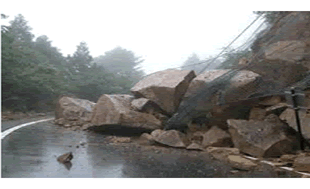vol. 3″Suspension of Construction”
- Landslides
If a slope on the side of road fails, it will cause serious damage not only to the vehicles driving down the road but also to the pedestrians. It is terrifying to imagine what would happen if massive boulders tumbled down the slope.

In order to prevent landslides like these, a variety of technologies have been developed. One such technologies is the method of covering the hillside with a metal mesh to prevent rocks from falling down. Even with a metal mesh; however, there are still problems because rocks may still break the metal mesh as they fall down.
An improved method to solve the problem has been patented. The method involves not only covering the slope with a metal mesh but also disposing simple parts on the metal mesh so as to anchor the metal mesh.
- Internal Quarrel Before Starting Work
Company X specialized in restorative construction work on hillsides and was contracted for post-disaster construction of a road together with a company that owned the above-mentioned patent. As it turned out, however, the patentee company could not participate in the construction work due to labor shortages. After a big fuss, Company X ended up undertaking the work by themselves. On the part of the patentee, they held a grudge against Company X because they would not be able to profit from the work. So, as soon as the work started, the patentee sent a warning letter to Company X demanding construction be stopped due to an infringement on the patent. - Asking For Our Advice
Company X approached our office for advice after they received the warning letter. They reached out to us after having consulted with their local patent office, whose advice was to suspend the work because they could not find any way to argue against the patent holder. Since suspending the work was not an option for them, they found us through a mutual acquaintance in order to find a solution. When ?we analyzed the patent rights, indeed there were only a few limitations on “the scope of claims,” which meant that the rights had a wide range of coverage, and I could not find a way to get around it.

Of course, we searched for publicly-known technologies that could become grounds for invalidation, with no success. ?On top of that, the patentee company demanded a reply within 10 days. The client had travelled a long distance to our office in Tokyo to get our advice. We would regret having to say, “Sorry, we are afraid there is no way out after all,” so we kept searching for a solution.
- An Idea!
Then, I got an idea. Let’s see…what was this work originally for? It was disaster-relief work! And what would it mean to demand work be stopped? It would mean just leaving the landslide to sit there, and that they wouldn’t care even if this triggered another disaster. Immediately, I sent a letter addressed directly to the president in the headquarters of the patentee company, in which I wrote: “Right now, your company is preventing disaster-relief work. We suppose you would not mind if this fact is reported by the mass media. We suppose your company would assume responsibility if any secondary disaster were to occur.”
Two days later, a manager of a branch office rushed to the construction site, and as soon as he came into the site office, he screamed out loud an order from the president, “We will not press charges against your patent infringement! Please resume the work immediately! Please hurry up so that a disaster won’t occur!”

Things do not always go this well. This was a special case where both parties had been on good terms before the bid, then later became at odds with each other. Whatever the case may be, we continue to educate ourselves so that we don’t have to tell our clients, “We are afraid there is no way out.”

